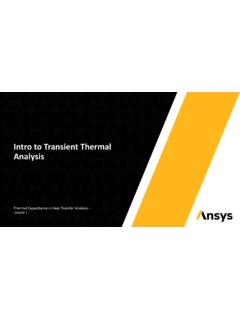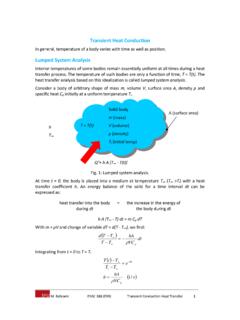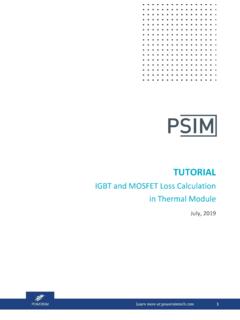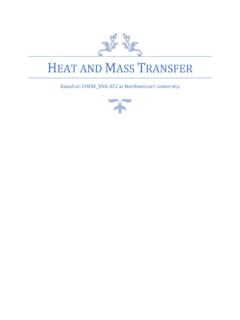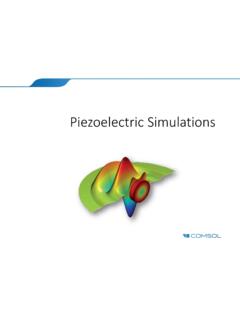Transcription of Section 4 Chapter 1 Fundamentals
1 Chapter ONE FUNDAMENTAL PRINCIPLES OF DRYING Arun S. Mujumdar and Sakamon Devahastin 1. INTRODUCTION The separation operation of drying converts a solid, semi-solid or liquid feedstock into a solid product by evaporation of the liquid into a vapor phase via application of heat . In the special case of freeze drying, which takes place below the triple point of the liquid being removed, drying occurs by sublimation of the solid phase directly into the vapor phase. This definition thus excludes conversion of a liquid phase into a concentrated liquid phase (evaporation), mechanical dewatering operations such as filtration, centrifugation, sedimentation, supercritical extraction of water from gels to produce extremely high porosity aerogels (extraction) or so-called drying of liquids and gases by use of molecular sieves (adsorption).
2 Phase change and production of a solid phase as end product are essential features of the drying process. Drying is an essential operation in the chemical, agricultural, biotechnology, food, polymer, ceramics, pharmaceutical, pulp and paper, mineral processing, and wood processing industries. Drying is perhaps the oldest, most common and most diverse of chemical engineering unit operations. Over four hundred types of dryers have been reported in the literature while over one hundred distinct types are commonly available. It competes with distillation as the most energy-intensive unit operation due to the high latent heat of vaporization and the inherent inefficiency of using hot air as the (most common) drying medium.
3 Various studies report national energy consumption for industrial drying operations ranging from 10-15% for USA, Canada, France, and UK to 20-25% for Denmark and Germany. The latter figures have been obtained recently based on mandatory energy audit data supplied by industry and hence are more reliable. FUNDAMENTAL PRINCIPLES OF DRYING _____ 2 Energy consumption in drying ranges from a low value of under five percent for the chemical process industries to thirty five percent for the papermaking operations. In the USA, for example, capital expenditures for dryers are estimated to be in the order of only $800 million per annum.
4 Thus, the major costs for dryers are in their operation rather than in their initial investment costs. Drying of various feedstocks is needed for one or several of the following reasons: need for easy-to-handle free-flowing solids, preservation and storage, reduction in cost of transportation, achieving desired quality of product, etc. In many processes, improper drying may lead to irreversible damage to product quality and hence a non-salable product. Before proceeding to the basic principles, it is useful to note the following unique features of drying which make it a fascinating and challenging area for R&D.
5 Product size may range from microns to tens of centimeters (in thickness or depth) Product porosity may range from zero to percent Drying times range from sec (drying of tissue paper) to five months (for certain hardwood species) Production capacities may range from kg/h to 100 t/h Product speeds range from zero (stationary) to 2000 m/s (tissue paper) Drying temperatures range from below the triple point to above the critical point of the liquid Operating pressure may range from fraction of a millibar to 25 atmospheres heat may be transferred continuously or intermittently by convection, conduction , radiation or electromagnetic fields Clearly, no single design procedure that can apply to all or even several of the dryer variants is possible.
6 It is therefore essential to revert to the Fundamentals of heat , mass and momentum transfer coupled with a knowledge of the material properties (quality) when attempting design of a dryer or analysis of an existing dryer. Mathematically speaking, all processes involved, even in the simplest dryer, are highly nonlinear and hence scale-up of dryers is generally very difficult. Experimentation at laboratory and pilot scales coupled with field experience and know-how is essential to the development of a new dryer application. Dryer vendors are necessarily specialized and normally offer only a narrow range of drying equipment.
7 The buyer must therefore be reasonably conversant with the basic knowledge of the wide assortment of dryers and be able to come up with an informal preliminary selection before going to the vendors with notable exceptions. In general, several different dryers may be able to handle a given application. 2. BASIC PRINCIPLES AND TERMINOLOGY Drying is a complex operation involving transient transfer of heat and mass along with several rate processes, such as physical or chemical transformations, which, in turn, FUNDAMENTAL PRINCIPLES OF DRYING _____ 3 may cause changes in product quality as well as the mechanisms of heat and mass transfer.
8 Physical changes that may occur include: shrinkage, puffing, crystallization, glass transitions. In some cases, desirable or undesirable chemical or biochemical reactions may occur leading to changes in color, texture, odor or other properties of the solid product. In the manufacture of catalysts, for example, drying conditions can yield significant differences in the activity of the catalyst by changing the internal surface area. Drying occurs by effecting vaporization of the liquid by supplying heat to the wet feedstock. As noted earlier, heat may be supplied by convection (direct dryers), by conduction (contact or indirect dryers), radiation or volumetrically by placing the wet material in a microwave or radio frequency electromagnetic field.
9 Over 85 percent of industrial dryers are of the convective type with hot air or direct combustion gases as the drying medium. Over 99 percent of the applications involve removal of water. All modes except the dielectric (microwave and radio frequency) supply heat at the boundaries of the drying object so that the heat must diffuse into the solid primarily by conduction . The liquid must travel to the boundary of the material before it is transported away by the carrier gas (or by application of vacuum for non-convective dryers). Transport of moisture within the solid may occur by any one or more of the following mechanisms of mass transfer.
10 Liquid diffusion, if the wet solid is at a temperature below the boiling point of the liquid Vapor diffusion, if the liquid vaporizes within material Knudsen diffusion, if drying takes place at very low temperatures and pressures, , in freeze drying Surface diffusion (possible although not proven) Hydrostatic pressure differences, when internal vaporization rates exceed the rate of vapor transport through the solid to the surroundings Combinations of the above mechanisms Note that since the physical structure of the drying solid is subject to change during drying the mechanisms of moisture transfer may also change with elapsed time of drying.
